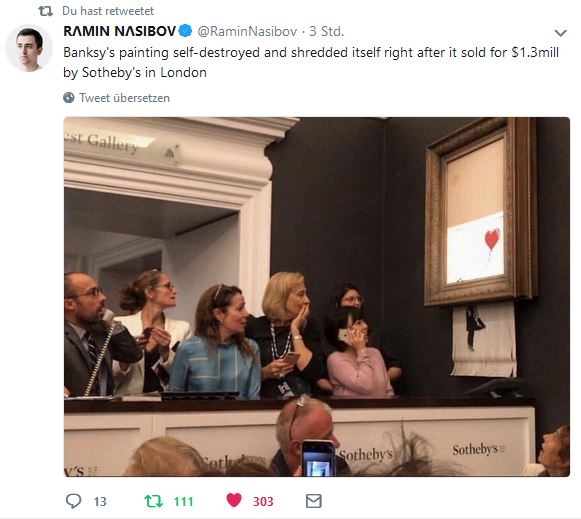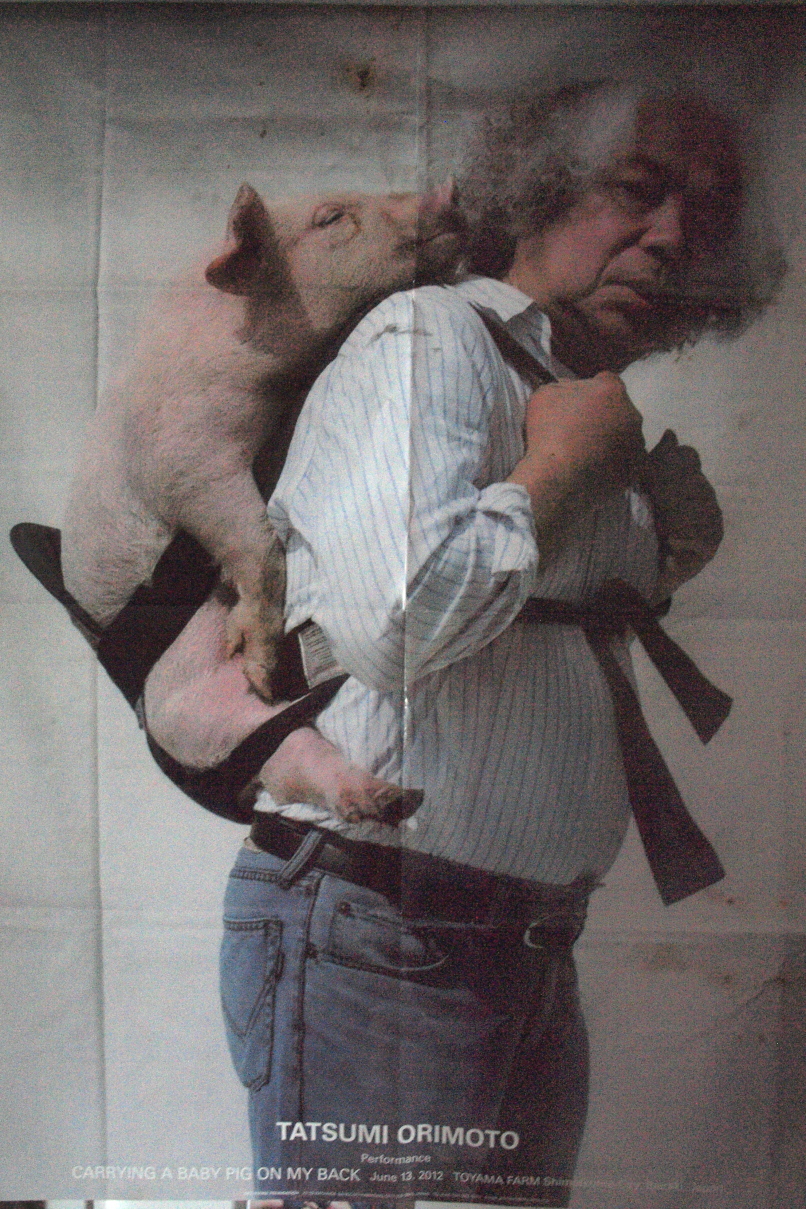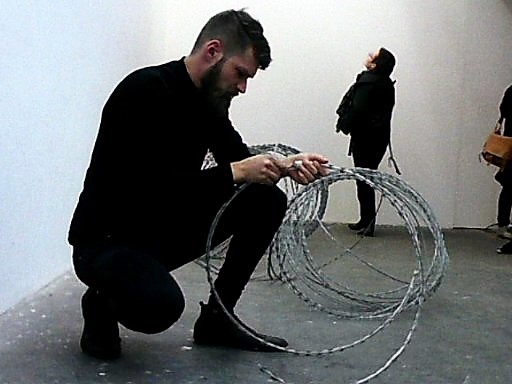Banksy, Metzger, Rühmann … (scroll down for English version)
Bei Sotheby’s wurde heute, am 6. Oktober 2018, ein Bild von Banksy für 1,3 Millionen $ versteigert. In den Bilderrahmen hatte der Künstler zuvor einen Schredder eingebaut, der das Bild nach der Versteigerung in Streifen schnitt. Das Fotos von Rasimov zeigt von dem bekannten Streetart-Motiv, dass die Figur schon zerschnitten unterhalb des Rahmens hängt und der Luftballon aus dem oberen Teil des Bildes im Rahmen schon nach unten gerutscht ist.

Twittermeldung vom 6. Okt 2018, Versteigerung von Sotheby’s, (c) Ramin Nasibov, Twitter @RaminNasibov
Mit dem Bild, das zur Aktion wurde, hat sich Banksy in die Reihe der Künstler eingefügt, die den Ikonoklasmus nicht den Bilderfeinden überlassen, sondern die mit ikonoklastischen Handlungen selbst ein Zeichen gegen die Inanspruchnahme von Kunst setzen.
Autodestructive Art 1960er
1960 stellte Gustav Metzger die ersten sich selbst zerstörenden Bilder her, die er „Auto Destructive Acid >Action< Paintings“ nannte. Öffentlich „bemalte“ er auf Rahmen gespannte Vinylfolien mit Säure, so dass sich die Bilder in kurzer Zeit auflösten. Ebenfalls 1960 veranstaltete Gustav Metzger das Destruction in Art Symposion (DIAS) in London.
Einen Akt der Sabotage der Ausstellung seiner Kunst lieferte auch der Hamburger Künstler Dieter Rühmann anlässlich der Verleihung des Lichtwark-Stipendiums, das er 1973 in der Hamburger Kunsthalle zugesprochen bekam. Als das Publikum den Ausstellungsraum betrat, schnitt Rühmann seine Bilder aus den Rahmen, so dass die zuvor dort präparierten und montierten Arbeiten eines Künstlerkollegen sichtbar wurden.
Ist Banksy überhaupt der Urheber der Zerstörung?
Die Arbeit von Rühmann zeigt aber auch was nach der Zerstörung passieren kann. Der Dienst den er seinem Kollegen erwies, dessen Bilder er freilegte, wurde Jahre später von einem anderen Kollegen erwidert. Es stellte sich heraus, dass dieser die Fetzen der Bilder, die Rühmann aus den Rahmen geschnitten hatte, geborgen hatte. Das Portrait brachte er restauriert zurück, während er die anderen als Lohn für seine Bemühungen behielt.
Die Weiterverwertung zeigt uns jetzt schon, dass der Sammler, der Banksys Bild erwarb, entweder die parallelen Streifen zusammenfügen lassen wird oder das Bild in seinem für einen Schablonendruck viel zu wuchtigen Rahmen als Dokument der Aktion präsentieren wird. Allein dieser Rahmen gibt aber zu denken. Wer hat entschieden, das Bild in so einem grotesken Rahmen anzubieten. War es ein abgekartetes Spiel, das inszeniert wurde, um Publizität zu erzeugen und Wertzuwachs in Sekundenschnelle zu generieren. Mit dem Rahmen zusammen hat sich der Kauf doppelt gelohnt, denn das Bild ist zum Dokument geworden. Ob es eines der Aktionskunst ist, muss sich erst noch erweisen.
© Johannes Lothar Schröder
A Banksy was sothebyed
For 1.3 Million USD the girl with the balloon went to Mr. or Mrs. XXX. However somebody built in a shredder into the frame, which began to work shortly after the auction. Social-media posts show half of the picture cut into strips looking out from under the frame.
No matter who designed the mechanism of autodestruction, that put Banksy into the line of iconoclastic artist, the happening brings into mind Gustav Metzger, the pioneer of autodestructive art. Since 1960 he executed several acid-paintings which destroyed themselves while being painted. By this he seriously avoids to be sothebyed nowadays after his dead in 2017.
A remarkable act of destruction of his own work of art was done by Hamburg based Dieter Rühmann, who during the opening of his show at the Hamburger Kunsthalle, cut his own artworks out of the frame, to show works of other artists, which were not honored by the Lichtwark-prize he has received.
Rühmann also shows that destruction is not only selfish and an act of self-promotion. It can also be an act of generosity as Rühmann offered his space in the frame of an exhibition to somebody else. Years after that one of the pictures he had cut out of the frame was returned to him by a colleague. He had collected the remains of the destruction and restored three of the pictures.
The grotesque frame, in which Banksy’s screen printing was presented, teaches another lesson: The new owner of the sheet has doubled the value of the work seconds after the purchase. The work is a document of destruction as well as it is a document of a coup. As the work was not given to Sotheby’s by Banksy himself, one can guess, that somebody else did the job of manipulating the frame not for artistic reason but to generate publicity.
© Johannes Lothar Schröder





